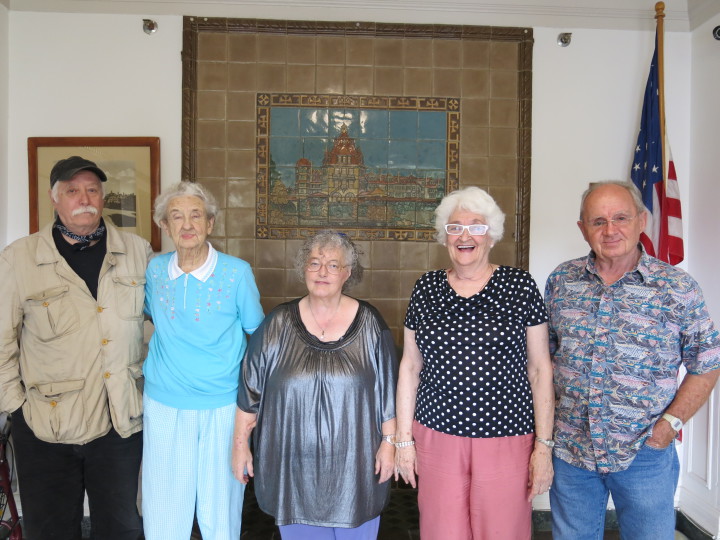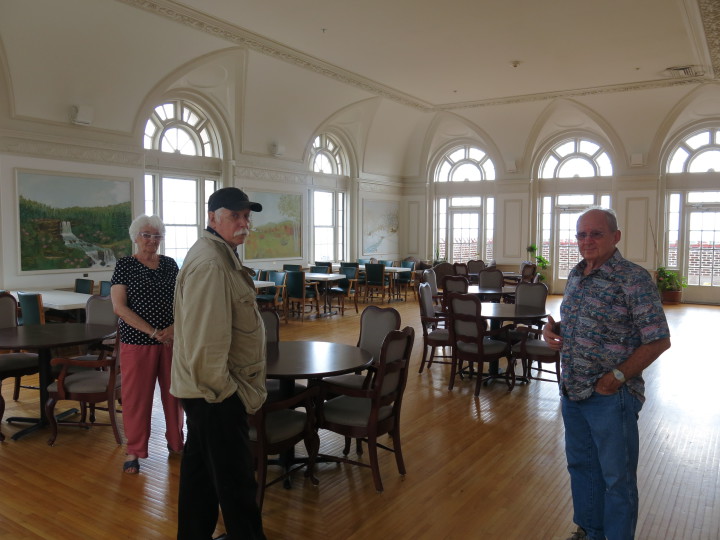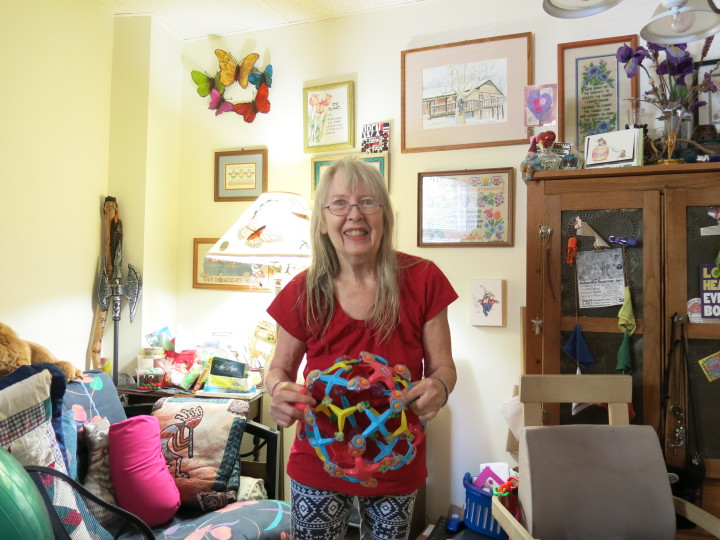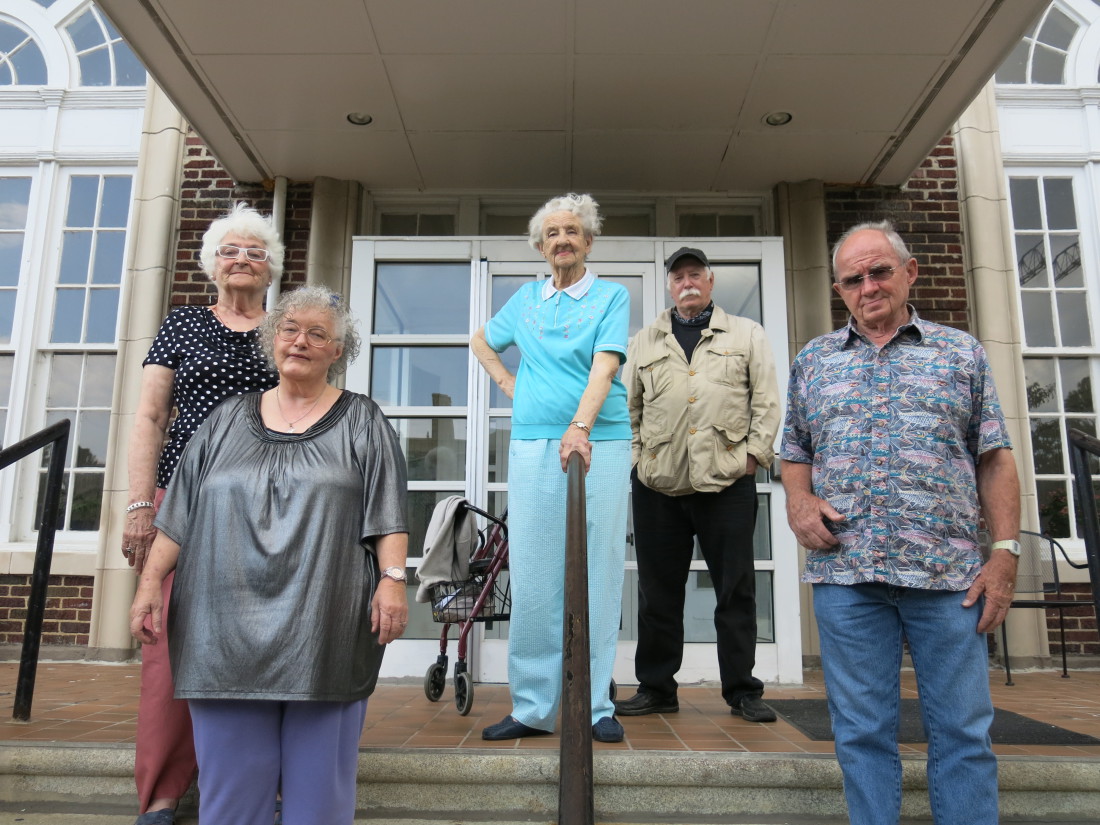When she was 27, Asheville resident Carol Hubbard survived a traumatic brain injury that nearly left her paralyzed. Back then, doctors wouldn’t recommend physical or speech therapy. “I couldn’t talk, couldn’t blow my nose, couldn’t tie my shoes,” she recalls. “It was a do-it-yourself rehab, but three years later, I was back in grad school.”
A clinical social worker in various cities for 25 years, Hubbard subsequently launched ACCESS Independent Living, an Asheville-based nonprofit that she says she had to “leave out on a cliff to die” in 2008 due to exhaustion. In 2012, however, Hubbard got involved with Interweave Asheville, an improv theater group for people of mixed abilities that holds its rehearsals, meetings and some performances in the historic Battery Park Apartments downtown. Almost immediately, says the now 65-year-old, she fell in love with the building. And in September 2014, after two years on the waiting list, Hubbard moved in. “I found my tribe,” she says. “Artists, creative people: I never felt so at home in my life.”
When it comes to finding suitable housing, however, not all local seniors fare as well. As of 2010, the Asheville area was home to 14,427 people 65 and over, census data show. And according to a 2015 Bowen National Research study prepared for the city’s Community and Economic Development Department, one in 11 seniors in Buncombe, Henderson, Madison and Transylvania counties lives in poverty. What’s more, the study predicts, between 2015 and 2020, seniors ages 65 to 74 will see the largest population increase of any age group in Western North Carolina (16.4 percent). Meanwhile, as of 2014, the median base monthly fee for independent senior living facilities in WNC was $1,250, the study notes.
“There’s a lot of conversation about workforce housing,” says Todd Puhl, regional vice president of National Church Residences. The nonprofit operates the former luxury hotel as a rent-subsidized complex for seniors and the disabled. “But I really don’t hear the conversation about what our seniors need.”
Jeff Staudinger, Asheville’s assistant director of community and economic development, says the city’s emphasis on developing more affordable single-bedroom units shows that older residents aren’t being overlooked. “That’s where we see the greatest deficit, in terms of demand for lower-income households” — some of whom are seniors.
Saved by the bell
The original Battery Park Hotel, a rambling frame structure built by Col. Frank Coxe, opened its doors on July 12, 1886. With a fireplace in each room, modern steam radiators and electric lights, it was considered among the finest and most modern resorts of its day.

By 1921, though, the old building had fallen into disrepair and was sold to Edwin W. Grove. The patent medicine magnate had already developed the Grove Park neighborhood and the Grove Park Inn. The Grove Arcade, which was under construction when he died, was completed in 1929. Rather than renovate the old hotel, Grove used early steam shovels to demolish both the building and Battery Porter Hill, on which it had stood, removing an estimated 250,000 cubic yards of earth (about 100 feet of height) in the process.
The new Battery Park opened for business in 1924, welcoming such luminaries as Ty Cobb, Babe Ruth, R.J. Reynolds, F. Scott Fitzgerald, Thomas Wolfe and Fritz Kreisler; a tile mural in the lobby pays homage to the hotel’s predecessor. Eventually, however, Grove’s hostelry also lost its shine. In 1955, Maurice Puckett acquired the Battery Park in a property swap; and in 1971, with downtown real estate not in great demand, Jack Bryant bought the hotel at public auction. Within a year, he’d shut it down, due to low occupancy.
Still, the property’s historical significance hadn’t been forgotten: In 1977, it was listed on the National Register of Historic Places. The following year, Battery Park Associates bought the building, spending $2 million to convert the 220 rooms into 122 apartments for senior citizens. National Church Residences acquired it in 2004.
“Without somebody like us coming in,” says Puhl, “it could easily have been high-end condominiums. … Our mission is to provide not only affordable housing for seniors but to also bring in … health services, transportation services, food services [and meet] medical needs.”
Money crunch
According to Staudinger, the push for more affordable senior housing “is probably going as well as it’s going for all our affordable housing.” He cites the city’s recent support, in various forms, of two such projects, at Givens Estates in South Asheville and, in partnership with Mountain Housing Opportunities, in Leicester.
Reduced federal funding, says Staudinger, has hampered affordable housing efforts, though he notes, “In response to that, the city has been making more local funds available than at any time, I think, in Asheville’s history.” And while he calls organizations like National Church Residences and the Asheville Housing Authority “absolutely essential” in addressing the shortfall, Staudinger stresses that “We need the private sector, which has typically not been creating affordable housing, to also be part of helping meet that need.”
Affordability is certainly a key component of the Battery Park’s appeal for seniors. Nondisabled people who earn less than 60 percent of the area’s median income can apply for a unit at age 62. All 122 units are subsidized by the Department of Housing and Urban Development, meaning residents pay no more than 30 percent of their adjusted gross income for rent. Not surprisingly, the waiting period for these units averages two and a half to three years.
Like a little lady with a hat on
It isn’t just about the money, however. Residents cite a variety of reasons for gravitating here.
Barbara Gravelle moved into the building in 2002. The 78-year-old poet and former teacher grew up in Nebo, just east of Marion; on weekends, the family would drive to downtown Asheville to shop. “We would come to the S&W, and I always felt a love for the [Battery Park],” she recalls. “It’s so beautiful: like a little lady with a hat on.”
Former educator Neill Clark says it was the old hotel’s history that attracted him. “I like it because of its association with Wolfe, Fitzgerald — all that,” he explains, adding, “Its ancestor, the one that was torn down, was even more elaborate.”
Other residents, however, point to darker chapters in the building’s rich history.
“Some will tell you the place is not just haunted but cursed, because of the injustice done in railroading a black man,” says writer and longtime activist Clare Hanrahan. On July 16, 1936, New York University student Helen Clevenger’s body was discovered in Room 224 with a fatal bullet wound to the chest. Martin Moore, a 22-year-old black employee, confessed to the murder but later said the confession had been forced. Moore maintained his innocence up until his execution on Dec. 11, 1936.
Booker T. Sherrill worked as a bell captain at the hotel from the 1930s until it closed in 1972. He lived in the Battery Park Apartments until his death on Oct. 30, 2003, at age 96.
Gravelle, who helped produce the Battery Park Post from 2003-10, wrote a piece on the building’s history that included Sherrill’s recollections of the Clevenger murder and his doubts about Moore’s guilt. Sherrill, remembers Gravelle, “would sit in his suit and tie in the lobby and read the newspaper every afternoon. He was just a really classy man and one of the oral history treasures at UNCA.”
A quirky bunch
Battery Park’s denizens are “truly a mix of people,” says Donna Nawrocki, services coordinator with the Council on Aging at Battery Park Apartments. “We have very liberal and very conservative residents. We have individuals here who were blue-collar workers. We also have a retired college professor. We have artists, we have writers, we have a little bit of everything. It’s very eclectic.”

Relaxing on the building’s front patio, 67-year-old Sue Hibbetts shares stories of her life before Battery Park. She moved into the complex at the beginning of this year, after living in a trailer in East Asheville for the previous 12. “I’m an unusual person,” she says. “I lived in Houston, Texas, for 30 years. I was a medical actor: I worked for Baylor College of Medicine and the University of Texas Medical School.” But that was only the tip of the iceberg, says Hibbetts, who did “all types of weird jobs to make ends meet,” including professional tarot reader, pet sitter and airport delivery and pickup driver. “You name it, I did it.”
Up in his seventh-floor apartment, 73-year-old Frank Mauldin also has some colorful tales to share, relics of a rough-and-tumble former life that included heavy drinking. Pointing to his glass eye, Mauldin explains, “I lost it in a fight in Nashville. I lived on the streets for years. You know that movie Midnight Cowboy? Well, I was like Rizzo. I’d break into vacant buildings, put broken glass on the stairs as a burglar alarm system.” Sober for 36 years, he says, “I’m a lot different now. I get a kick out of the people living here. Every one of them is really quirky.”
Not for sissies
Various on-site programs contribute to the quality of life at the Battery Park. Each semester, nursing students from Western Carolina University make in-home visits to residents with chronic health issues and those recovering from recent surgeries. Once a month, Dr. Ellen Kaczmarek, an Asheville-based geriatrics specialist, gives a talk and answers questions about health concerns. There are tai chi classes on Monday and Friday, and qi gong classes on Thursday night.
On the fourth Monday of each month, Nawrocki picks up donations from MANNA FoodBank for distribution to residents. On the second Tuesday of the month, the YMCA’s mobile healthy living food market arrives. In addition, there are art classes, free and discounted tickets, and even foot massages and chair yoga provided by Warren Wilson College students.
But while residents are quick to point out and praise the many perks, low income is still low income, and aging is still aging.
“I had not planned to live my years like I am,” says Hibbetts, whose sole income now is her $800 monthly Social Security check. “That bothers me. It’s a constant struggle to deal with. I try not to let the poverty issue become me, but sometimes it does.”
Clark, meanwhile, says that near the end of his career as an educator, he came to a crossroads. “I said, ‘Well, there’s two ways to go: You can work as much as you can and try to get as much money to live the way you want to, or you could learn to do without as much as you can. That’s sort of the two ways an old person faces life.’ And the more I thought about it, the more sense it made to go on the cheap: Live within your means; get rid of stuff.”
Living frugally, though, doesn’t totally solve the problem. “I’ve been really obsessed lately with what happens if I get really old and need institutionalized care,” Hubbard says. The Battery Park doesn’t offer assisted living services. “If I can’t take care of myself, I’ll be screwed,” she continues. “I don’t have money to pay for it.”
Clara Byrd — one of the facility’s three nonagenarian residents — has lived here since 1995. And while she’s grateful for the amenities and opportunities provided, there are also many challenges. “I’ve been a very active person all my life. But I turned 90, and all of a sudden it hit me like a ton of bricks. And that really frustrates me. … I can’t walk and go downtown like I used to. My legs are in bad shape, and I got a heart problem and a breathing problem.” Pausing for a moment to gather her thoughts, she proclaims, “Old age is not for sissies.”
Death in the afternoon
In the nearby Battery Park Book Exchange, Gravelle and Hanrahan are enjoying a Death in the Afternoon, a cocktail named after Ernest Hemingway’s monumental exploration of bullfighting. The conversation ranges from art to poetry to history to Buddhism. By the time both women have finished their drinks, the topic of death comes up.
At the Battery Park, says Hanrahan, “I’m finding you live constantly with the awareness of the end of life.” Recently, she recalls, a fellow resident told Hanrahan she felt her remaining time on Earth was limited. “She was very brave about it; she was speaking about it directly. To me, these are wonderful opportunities to be open to what’s real in the world.”
Gravelle adds, “We have plans for living wills; that’s part of our lady from the Council of Aging’s job. We have all kind of health programs. After a certain age, you need to have a living will and you need to have a cremation fund.”
Resting her head in the palm of her hand, Hanrahan looks across the table at Gravelle, saying, “I can’t imagine you a pile of ashes, Barbara.” Both women laugh.
In general, residents don’t seem to shy away from the topic. Their approaches to and views on death may differ, but as a subject, it’s something they’re willing to confront. “I view it all in a medieval context,” says Clark. “The memento mori, in which one reflects on death every day because that is your fate. So the up-close-and-personal stuff here is simply a more vivid reminder of that fact.”
“It’s inevitable,” says Hibbetts. “I guess I’m afraid of the pain of death more than death itself. I’m a pagan, so I think everything goes to the ground and comes back up in another form: It’s a cycle.”
Hubbard, however, says that thanks to her near-death experience at age 27, she knows that there’s nothing to fear. “I was on my way to my maker,” she says. “I wanted to keep going into that beautiful, lovely light that you could hear and feel and see. It was incredible.”
A longer view
Despite the undeniable challenges, Battery Park residents also emphasize the upside of aging. And though much of the process seems to involve shrinking — whether physically, financially or simply in terms of how much time remains — many say they experience an expansion of thought and perspective. Nawrocki, the on-site coordinator, spends much of her time meeting with residents — addressing their concerns, helping them with Medicare or Medicaid questions, but also simply lending an ear.

“I think we miss out on a lot of wisdom and input that seniors have,” she says. “We miss out by not capturing that and not listening to them.”
For Hanrahan, one of the benefits of aging is what she calls “a sense of owning your wisdom. It’s not a hubris thing: It’s just a reality. We have a longer view.” And with that comes a greater acceptance of one’s own shortcomings which, in turn, seems to fuel a greater confidence in and appreciation of the total self.
“You sweat the small stuff less,” says Hubbard. “You care less what other people think. You’re a little more settled, a little less reactive. You don’t take things so seriously. You realize that everything is going to change; everything is going to pass. That’s the best of it: You’re a little more mellow.”




I attended a junior/ senior dance up on the top floor now known as the community room. The view was spectacular.
Earlier in my life I had developed an allergy to bee stings. The physian who treated me had an office on the first floor of the Battery Park.
Enjoy reading all your stories.
My mother loved having lunch on the ground floor of the Battery Park and my husband’s aunt lived there for years! Thank you so much for this great article. You have reminded us that listening to our elders is well worth our time. These are all folks I would love to call my friends!!!
If we had limited highrise hotels then, we wouldn’t have affordable housing now, duh! It is impossible to build affordable housing because newness is a luxury in itself, inherently. Any new housing is inherently at least middle class.
One of the current residents is a woman, now almost 90, who sold newspapers from behind a counter in the lobby when she was just a slip of a thing.
Aren’t these the same people who forced Battery Park Book to relocate because they left their cars parked on the street for months?
no
I believe they are:
https://issuu.com/mountainx/docs/mountain_xpress_09_22_2010
Though I could be wrong:
The placard stops here
Posted on September 21, 2010 by David Forbes
“Some disabled downtown residents see the issue quite differently, however. Many have physical problems that make it impossible for them to use the decks. And in a lot of cases, these folks point out, they’re merely parking where they live. In particular, residents of the Battery Park Apartments, which provides subsidized housing for the elderly, have contacted city officials to register their objections to the proposed changes. A number of those residents sat down with this reporter recently to share their concerns.”
https://mountainx.com/news/community-news/092210the-placard-stops-here/
Additional History:
E.W. Grove built the 2nd Battery Park as a poke at son-in-law Fred Seely who was managing the Grove Park Inn. Thought it would take some business away from the GPI. Grove died Jan 27, 1927 and stiffed Seely out of owning the GPI (Seely sued in 1928 St. Louis trial and lost). However, Seely’s wife, Evelyn Grove Seely, inherited the Battery Park from her daddy. Mrs. Seely moved from Seely Castle to the Battery Park in March of 1942 and lived her final days in the top of the Battery Park. Grandchildren would visit and toss water balloons of the outside porches. Look out below! Mrs. Seely died in 1953 and the hotel was lost in a 1955 court battle over funds being mismanaged. Sold! said the court. So, Seelys and Groves were now out of the hotel business for good.
Doctor Battle,, for whom Battle Square was named had an office in the BPHotel What year did John Calder visit a doctor here?